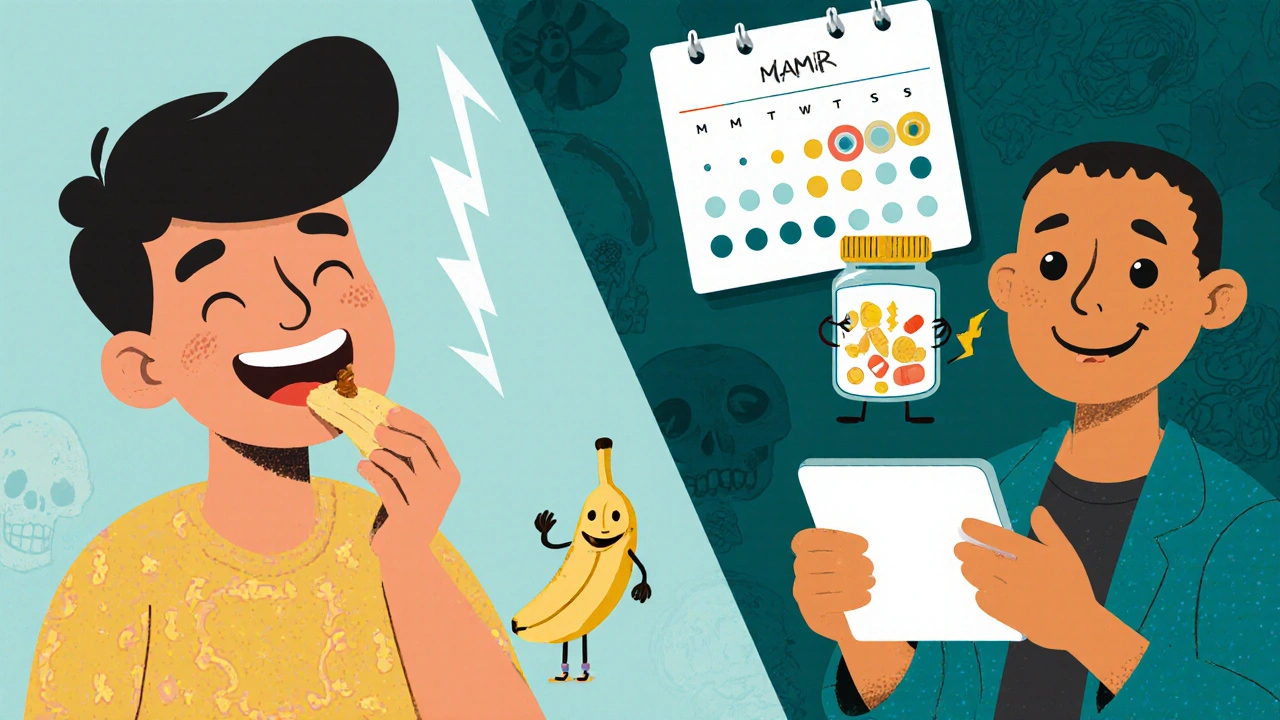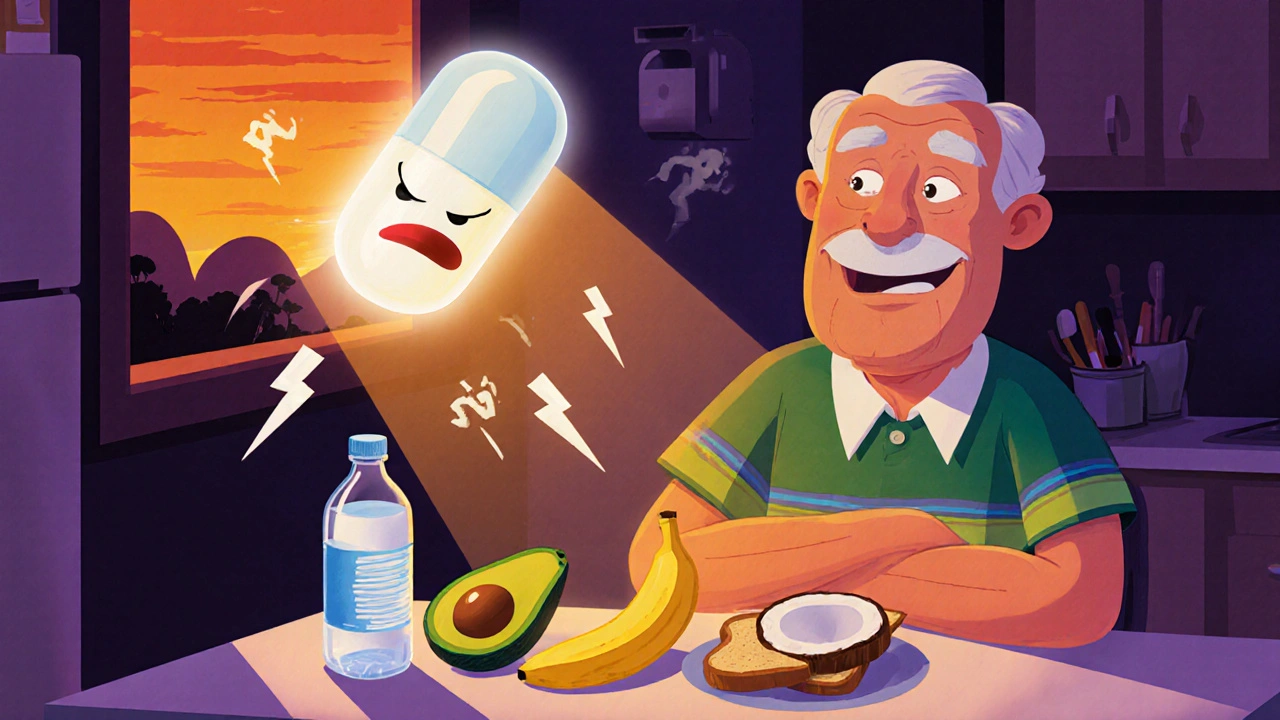Many people take ACE inhibitors like lisinopril to manage high blood pressure or protect their kidneys, especially if they have diabetes. But what they don’t always realize is that everyday foods-bananas, potatoes, avocados, even salt substitutes-can quietly push their potassium levels into dangerous territory. This isn’t a myth. It’s a real, documented risk that sends thousands to the ER every year.
How ACE Inhibitors Affect Potassium
ACE inhibitors work by blocking a chemical in your body called angiotensin II. That helps relax your blood vessels and lower blood pressure. But here’s the catch: when that chemical is blocked, your kidneys don’t get the signal to flush out potassium. So instead of excreting it, your body holds onto it. That’s why your serum potassium can creep up-even if you’re eating the same diet you always have.
For someone with healthy kidneys, this increase is usually small-around 0.5 to 1.0 mmol/L. But for someone with kidney disease, diabetes, or who’s over 65, that number can jump by 1.5 to 2.5 mmol/L. And when potassium hits above 5.0 mmol/L, you’re in danger zone. Above 6.0? That’s a medical emergency. Irregular heartbeat, muscle weakness, nausea, even cardiac arrest can follow.
Which Foods Are the Biggest Culprits?
You don’t need to eliminate all potassium. But you do need to know which foods pack the biggest punch-and how much you’re actually eating.
- Bananas: One medium banana has about 326 mg of potassium. Two a day? That’s over 650 mg-nearly a third of your daily limit if you’re at risk.
- Avocados: Half an avocado? Around 345 mg. Add it to your toast, salad, or smoothie, and you’re already close to your daily buffer.
- White and sweet potatoes: One medium baked potato has 670 mg. Baked, mashed, fried-it doesn’t matter. The potassium stays.
- Tomatoes and tomato products: A cup of tomato sauce has nearly 900 mg. Pasta sauce, canned tomatoes, ketchup-they all add up fast.
- Dried fruits: Four dried apricots? Over 300 mg. Easy to snack on, hard to track.
- Salt substitutes: Products like Nu-Salt or NoSalt replace sodium with potassium chloride. One tiny 1.25g serving? 525 mg of potassium. Many people think they’re doing the right thing by switching, but they’re accidentally poisoning themselves.
- Coconut water: One bottle can have 1,500 mg. It’s marketed as a ‘healthy’ drink, but for someone on lisinopril? It’s a ticking time bomb.
Here’s the hard truth: you don’t need to quit these foods cold turkey. But if you’re eating multiple servings daily-especially if you’re older, diabetic, or have kidney issues-you’re playing Russian roulette with your heart.
Who’s at Highest Risk?
Not everyone on ACE inhibitors needs to worry. But some groups are far more vulnerable.
- People with chronic kidney disease (CKD) stages 3-4: Their risk of hyperkalemia is over 12% per year-ten times higher than someone with healthy kidneys.
- Diabetics: Diabetes damages the kidneys over time. Even mild kidney changes make potassium harder to clear. Diabetics on ACE inhibitors are more than three times as likely to develop dangerous high potassium.
- Older adults: Kidney function naturally declines after 60. Many don’t know their kidneys are slowing down until it’s too late.
- People taking other potassium-raising drugs: Combining ACE inhibitors with spironolactone, eplerenone, or trimethoprim? That’s a 300-400% jump in hyperkalemia risk. This combo is common in heart failure patients-but often not flagged.
And here’s something most doctors don’t tell you: genetic factors matter. A 2023 study found that people with a specific variation in the WNK1 gene are over five times more likely to develop hyperkalemia on ACE inhibitors. You can’t change your genes-but you can get tested if you’ve had repeated high potassium levels.
What the Research Really Says
You’ve probably heard conflicting advice. Some say, ‘Eat as many bananas as you want.’ Others say, ‘Avoid all potassium.’ The truth? It’s somewhere in between.
A 2016 study in the Journal of the American College of Cardiology found that people with normal kidney function could safely eat 3,400-4,700 mg of potassium daily-even while on ACE inhibitors. But that study didn’t include people with kidney disease. And it didn’t account for the fact that most people on these drugs don’t have perfect kidney function.
Meanwhile, real-world data tells a different story. Nurses on Reddit report multiple patients hospitalized after drinking coconut water daily. One patient on Drugs.com saw their potassium spike to 5.8 after eating two bananas a day for weeks-no one warned them.
So what’s the right approach? It’s not about fear. It’s about awareness.
What You Should Do
If you’re on an ACE inhibitor, here’s what actually works:
- Get your potassium tested. Before you start the medication, and again 1-2 weeks after starting or changing your dose. Then every 3-6 months if you’re stable. If you have kidney disease or diabetes, test monthly.
- Know your numbers. Normal potassium is 3.5-5.0 mmol/L. Anything above 5.0 needs attention. Above 6.0? Go to the ER.
- Track your intake. Use a food app for a week. See how many high-potassium foods you’re eating. You might be surprised.
- Time your meals. Eat high-potassium foods 2 hours before or after your ACE inhibitor. Research shows this cuts the potassium spike by 25%.
- Avoid salt substitutes. Seriously. Even the ones labeled ‘natural’ or ‘healthy.’ They’re loaded with potassium chloride.
- Ask your doctor about alternatives. If you keep having high potassium, ask if switching to an ARB (like losartan) might be safer. ARBs carry about 60% of the potassium risk of ACE inhibitors.
And if you’re eating a lot of fruits, vegetables, and whole grains because you think it’s ‘heart-healthy’? You’re right-but not if your kidneys can’t keep up. The goal isn’t to eat less healthy food. It’s to eat smart.

What’s New in 2025?
There’s good news. New treatments are making it easier to stay on ACE inhibitors without cutting out your favorite foods.
One drug, patiromer (Veltassa), was approved in 2015 to bind potassium in the gut so it doesn’t enter your bloodstream. A 2023 trial showed 89% of patients who couldn’t tolerate potassium-rich foods because of high levels were able to resume their diet after starting patiromer-while still staying on their ACE inhibitor.
The FDA’s 2023 draft guidance now recommends personalized advice, not blanket restrictions. If you have normal kidney function and no other risk factors, you may not need to change your diet at all. But if you’re diabetic, over 65, or have any kidney issues? You need a plan.
Telehealth is helping too. Remote potassium monitoring programs have cut hospitalizations by 28% in the last two years. If your doctor offers home testing or wearable monitors, take them up on it.
Bottom Line
ACE inhibitors save lives. But they’re not harmless. High-potassium foods aren’t the enemy-but ignoring their impact can be deadly. You don’t need to become a nutritionist. You just need to know your risk, get tested, and make small, smart changes.
If you’re on lisinopril, enalapril, or any ACE inhibitor, ask your doctor: ‘What’s my potassium level? Am I at risk? Do I need to change what I eat?’ Don’t wait for symptoms. By the time you feel weak or notice your heart racing, it might be too late.
Can I still eat bananas if I take ACE inhibitors?
It depends. If you have healthy kidneys and no other risk factors, one banana a day is usually fine. But if you have diabetes, kidney disease, are over 65, or take other medications like spironolactone, even one banana daily can push your potassium into the danger zone. Get your blood tested before assuming it’s safe.
What are the symptoms of high potassium?
Early signs are subtle: muscle weakness, tingling, nausea, or irregular heartbeat. Many people mistake them for fatigue or the flu. Severe cases include chest pain, difficulty breathing, or sudden heart rhythm changes. If you feel your heart skipping beats or your arms going numb, seek help immediately. High potassium can cause cardiac arrest without warning.
Is it safe to use salt substitutes on ACE inhibitors?
No. Most salt substitutes replace sodium with potassium chloride. One small serving can contain over 500 mg of potassium-more than half the daily limit for high-risk patients. Even if you’re using it to lower sodium, you’re risking hyperkalemia. Use regular salt in moderation instead, or ask your doctor about potassium-free alternatives.
Do all ACE inhibitors carry the same potassium risk?
No. Studies show enalapril has about a 15% higher risk of raising potassium than lisinopril at the same dose. This is due to differences in how the drugs are absorbed and how long they stay active in the body. If you’ve had high potassium before, ask your doctor if switching to lisinopril might be safer for you.
Can I stop eating potassium-rich foods altogether?
Not recommended. Potassium is essential for heart and muscle function. Cutting it out completely can cause low potassium (hypokalemia), which is also dangerous. The goal isn’t elimination-it’s balance. Focus on portion control, avoid high-potassium foods in large amounts, and prioritize variety. Most people can still enjoy fruits and vegetables safely with the right monitoring.
How often should I get my potassium checked?
Baseline test before starting. Then 1-2 weeks after starting or changing your dose. After that, every 3-6 months if you’re stable and have normal kidney function. If you have diabetes, kidney disease, or are over 65, get tested every month until your levels are stable. Don’t wait for symptoms-by then, it’s too late.
Are there alternatives to ACE inhibitors that don’t raise potassium?
Yes. Angiotensin II receptor blockers (ARBs) like losartan or valsartan raise potassium less-about 60% of the risk of ACE inhibitors. Calcium channel blockers and thiazide diuretics actually lower potassium. If you keep having high potassium, ask your doctor if switching to one of these might be a better option for you.


Written by Guy Boertje
View all posts by: Guy Boertje